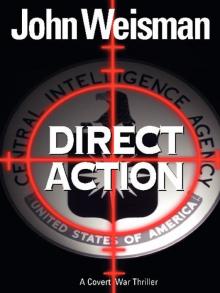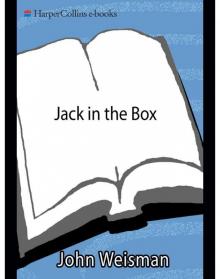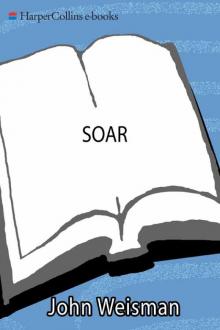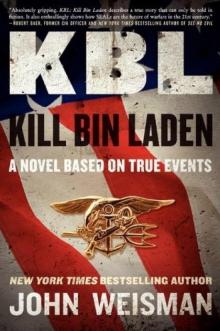- Home
- John Weisman
Jack in the Box Page 5
Jack in the Box Read online
Page 5
Sam decided to provoke O’Neill. “Well, you know, Michael, stuff like that, it’s all about sources. Depends where you heard it.”
“Well,” O’Neill said petulantly, “I heard it up on—” And then he thought better of disclosing where he’d been and stopped himself in midsentence.
But it was too late. In the rarefied jargon of Washington official speak, “up” always meant Capitol Hill. So, Sam knew that O’Neill heard it somewhere in Congress, which meant someone on one of the intelligence committee staffs was gossiping to O’Neill, which in turn indicated the comment had originated inside the intelligence community. Which confirmed Michael O’Neill was still working on the Dark Side every now and then. Give a little, get a lot.
Satisfied, Sam filed O’Neill’s gaffe away for later use. “Maybe it’s all an act. Remember what Sun-tzu said: ‘All war is deception.’ Maybe Ed Howard just wants us to think he’s a second-rate hack. After all, President Putin is former KGB—maybe he’s targeting some kind of dezinformatsia program at us.”
“That’s not the thinking at Langley, Sam.”
“It wouldn’t be. Czar Nicholas and Vlad Putin are best friends these days.”
“Moscow has been extremely helpful since 9/11.”
Sam’s eyes went cold. “Moscow never acts except in its own self-interest,” he said. “Never has, never will.”
O’Neill stared across the bar at the clock on the back wall. “Ever the Cold Warrior, eh, Cyrus?”
Sam said, “Some things die hard, Michael.” But it wasn’t the Cold War he was thinking about.
O’Neill said: “Besides, Ed Howard’s never been able to do us any real damage.”
Sam said nothing.
“C’mon, Sam.”
Sam examined O’Neill’s face. The problem was, O’Neill hadn’t spent enough time in the street. He’d been a case officer for less than half a decade. He’d been taught most of the moves. But he’d never developed the antennae you get with a quarter century of clandestine warfare. Besides, O’Neill was far too trusting and far too glib. They might be endearing traits. But not on the street. On the street they were vulnerabilities. And vulnerabilities will always be exploited.
O’Neill nudged his friend. “C’mon, Sam.”
It was time to give O’Neill an education. “Remember where Ed Howard works these days?”
O’Neill scratched alongside his left ear. “Moscow Center.”
“But where in Moscow Center?”
The lawyer shrugged. “Dunno.”
“CI,” Sam said, tapping the center of O’Neill’s vest, an inch above the gold watch chain. “Counterintelligence. The way I see it, about half the agents we lost that were credited to Ames and Hanssen were targeted by Ed Howard and betrayed by his moles in Washington. And I think he’s still running people here.”
“Impossible.”
Sam remembered the broken cigarette jammed in Pavel Baranov’s mouth and knew that nothing was impossible.
He looked at Michael O’Neill, his face dark with anger. “Edward Lee Howard has blood on his hands. And Vlad Putin’s no friend. End of story.”
Michael O’Neill shook his head in disbelief. “But that’s only your supposition, Sam. You weren’t ever able to prove it, were you?”
“If I’d been able to prove it, I’d still be working at Langley—and Czar Nicholas would be out of a job.”
“Wouldn’t that be lovely.” O’Neill set his glass down. “I’m going to the head,” he said. “Back in a minute.”
Sam watched the attorney slalom around the tables and chairs, past the tweedy Alien who was staring down at a glass of house red so he wouldn’t have to make eye contact. Sam plucked a Brazil nut from the bowl, chewed it, and washed it down with a full glass of water.
Okay, so O’Neill thought his Edward Howard theory was crazy. Hell, this wasn’t the first time it had been dismissed out of hand.
ON FEBRUARY 21, 2001, Sam drove from Purgatory out the George Washington Parkway, turned off at the entrance to the George Herbert Walker Bush Center for Intelligence, parked in the visitors’ lot, badged his way through the turnstile, took the elevator to the sixth floor, marched into the office of the assistant deputy director for counterintelligence, and declared, “Tom, we have to look at Robert Hanssen as a disposable.”
The ADDCI looked up at Sam pie-eyed. “You’re kidding me, right, Sam?”
“No, I’m dead serious.” Sam knew he was probably talking to a wall. Tom Jorgensen was a former reports officer who’d never served overseas or run an agent. He was a Langley apparatchik—yet another archetypal, four-eyed Romanoff, sartorially understated in an ill-fitting Hugo Boss knockoff, a gray Regis Philbin signature shirt, and nylon burgundy tie knotted in a triple Windsor the size of a child’s fist.
But perhaps even Jorgensen could be enlightened. Sam dragged a chair up to Jorgensen’s desk, dropped into it, and set both elbows on the ADDCI’s Grade One walnut veneer.
Jorgensen, who detested such proximity, suppressed the urge to scream for help. He swallowed hard and said, as slowly and calmly as he could, “It’s your … supposition, your … theory that it was the Russians who allowed us to uncover Robert Hanssen?”
“Absolutely.” Sam slapped his palm on the desk. “Hanssen is a diversion—just like Ames was—to keep us away from Moscow’s principal agents.”
“Ames, too.” Jorgensen rolled his chair away from the desk, putting distance between them. “That’s fascinating, Sam, absolutely fascinating. And the proof?”
“Isn’t it obvious?”
Jorgensen eased behind his three-tiered in-box so that Sam couldn’t stare directly at him. His fingertips began to drum the edge of his desk nervously. “Why don’t you tell me.”
Sam scraped his chair across the carpet to reestablish eye contact. “Ed Howard,” he said.
“The defector.” Jorgensen moved farther behind the inbox barricade.
Sam played peekaboo. “Putin has put Ed Howard in charge of a large-scale covert action program.”
“Putin. Vladimir Putin.”
“Precisely. The Russian president. Putin’s making us believe we’ve plugged all the holes when in fact we’re more porous than we’ve ever been.” Sam paused. “During my tour in Moscow, the Russians lost Ames and Nicholson, right?”
Jorgensen scratched his chin. “I guess.”
“Well, you lose one agent—that’s normal. Agents get caught. But two? With two, you start looking for anomalies.”
Sam caught the look on Jorgensen’s face and saw he was talking to a wall. But he kept on. “But the Russians never started looking for anomalies.” He paused. “Doesn’t that tell you something?”
Jorgensen responded by moving farther behind his in-box.
“It told me the Russians weren’t worried because they had other, better-placed agents. And Hanssen’s arrest proves my case. Now, Moscow let us have Hanssen because he’s outlived his usefulness and they’ve got at least one more highly placed source—most likely here, at the assistant-deputy-director level and maybe even higher. There are others, too. Probably at the White House and State.”
The ADDCI’s fingers were now moving so fast he looked as if he was playing a fragment from Bach’s Goldberg Variations. After six and a half very frantic measures, Jorgensen rolled out from behind the in-box and said, as reassuringly as possible, “Disposables? Anomalies? Sam, I think you need to take some vacation time.”
Fifteen seconds after Sam had left his office, Jorgensen was on the line to Nick Becker’s executive assistant.
SAM WAS PLAYING CHESS with his martini olives as
Michael O’Neill made his way back into the bar.
The attorney drained his cocktail, pulled the pocket watch out, and squinted at the dial. “You know, Sam,” he said, “Jim Angleton saw conspiracies, too, and talked about them loudly. Remember where it got the late and lamented counterintelligence chief.”
“Same place it got me,” Sam said.
; “Think about that.”
Sam had to admit O’Neill was right. He should have kept his damn mouth shut. Indeed, committing truth hadn’t done him any good. No good at all.
Which was bizarre. Because for twenty-six years he’d worked for an organization above whose main entryway, carved in foot-high letters, was the legend:KNOW YE THE TRUTH, AND THE TRUTH SHALL MAKE YOU FREE.
Yeah—right. And if you believe that, Sam thought, I have some Chechen bearer bonds to sell you, cheap.
He stared into his glass. Well, at least he’d been right about not committing truth when it had come to Baranov. He’d never divulged what the general had showed him to anyone at CIA. He’d rationalized at the time that if the document had been real, the unknown traitors would manage to cover their tracks and melt away forever. And if it had been a fabrication, the simple act of reporting its existence would have resulted in precisely the kind of confusion the Russians had wanted to generate.
Besides, Sam was punctilious when it came to double-checking agents’ claims, and there were just too many questions left unanswered. For example, the page Baranov showed him had been dated October 12—a Monday. But was the date valid, or had it been a fabrication?
After he’d been sent back to Washington, he’d checked online and discovered that on October 15, the Thursday following the meeting described in Baranov’s document, the Washington Times had run a three-paragraph story by Bill Gertz citing unnamed intelligence sources, and containing approximately the same details as the page of typing he’d been shown on October 23. To Sam, that was reason enough to cause him to doubt Baranov’s bona fides. So he’d simply left the document out of his reports.
Not that he’d never told anyone. He had in fact described the Baranov document in March 2000, during an unauthorized trip to Capitol Hill. And in a way, that particular truth had set him free—by ending his career. But that was another story for another day.
In fact, Sam wondered if Rand Arthur, the two-faced son of a bitch who was currently ranking member of the Senate Select Committee on Intelligence, had tasked O’Neill to elicit him on the subject of Pavel Baranov. O’Neill did the occasional odd job for Senate Select.
But if so, why? After all, Rand Arthur already knew all about Pavel Baranov. Sam had told him.
O’Neill was checking his watch again, his face tinged with concern like a conductor whose train is running late. Then he turned toward Sam, his expression suddenly quite grave. “I need your presence, Sam.”
“My presence.”
“Yes, your presence. It’s required.”
“Does that mean you want to hire me?” Waterman’s tone took on a sardonic edge. “Does your firm want someone shadowed? Are you requesting due diligence? That’s me: Samuel Elbridge Waterman. Dedicated due diligence done dirt cheap.” And then he read O’Neill’s face, and realized his former colleague was dead serious.
“No, I’m not talking about hiring you.” O’Neill inclined his head so his lips almost brushed Sam’s ear. “I’m not here by accident. I really was sent—to find you.”
The attorney pushed his empty martini glass across the bar. He stepped back and checked his pocket watch a third time. “Someone needs to see you, Sam—needs to see you now.”
CHAPTER 5
SAM DROPPED into the cold leather bucket seat of Michael O’Neill’s vintage Mercedes coupe, slammed the door, and snugged the seat belt over his big frame. “Who wants to see me?”
“You’ll know when we get there.”
“Where are we going”
“You’ll know when we get there.”
“What’s the big mystery?”
“You’ll know when—”
“Michael,” Waterman interrupted, “are you aware you’ve started to repeat yourself? It’s the first sign of dementia. Pretty soon you’ll be hiding your own Easter eggs.”
O’Neill grunted in response and nosed the car out of the alley behind the club. He crossed Florida Avenue and turned south. At Massachusetts Avenue he made an illegal right turn, careened three quarters of the way around Sheridan Circle, then went south, back the way he’d come. At Twenty-first and Mass, O’Neill drifted around the corner, sped past the cabs stacked two deep outside the Westin’s awning, shot halfway down the block, then abruptly cut into a narrow, one-way alley that ran the length of the block.
“You’re going the wrong way.” Sam listened to the car’s ancient transmission and suspension go through hell. “Michael, what in heaven’s name—”
“Tradecraft, Cyrus, tradecraft.” O’Neill stared straight ahead. At Twenty-third Street he worked his way across two lanes of gridlocked northbound traffic, turned south, and crossed P just as the light went red. “I’m checking to see if anyone’s following us.”
“If you keep driving like this, we’re guaranteed to pick up surveillance—traffic cops, all waving ticket books.”
It began to drizzle. With the single windshield wiper beating syncopation, O’Neill slalomed down Twenty-third Street. Just south of Virginia Avenue, O’Neill flicked his chin toward a gated, fenced compound whose entry sign bore the legend U.S.NAVAL MEDICAL FACILITY.
The sandbagged main gate disappeared from view. O’Neill glanced toward the installation’s thick concrete retaining wall, which ran all the way to C Street. “Hey, what good times we had up there, eh, Sam?”
Like many government installations in the National Capital Region, this one was purposefully mislabeled. In point of fact, five structures out of the seven-building U.S. Navy complex, which sat due west of the two-square-block Department of State headquarters building, belonged to the CIA. The Agency’s Technical Services Division, known in-house as “Invisible, Inc.” was located there. Inside three huge redbrick warehouses shielded by lead, white sound, and electronic countermeasures from any kind of hostile surveillance activity, dozens of creative, dedicated, and resourceful government artists forged documents, concocted disguises, and built a dizzying assortment of high-tech spy gadgets. And the aging three-story, slate-roofed, mustard yellow Big House, built in the late 1930s for the War Department, was used as the staging area for the Agency’s denied area operations course, or DAO, a monthlong, eighteen-hour-a-day immersion program in countersurveillance tradecraft required for all case officers assigned to hard-duty stations like Moscow, Delhi, or Paris.
Sam was more interested in finding out what O’Neill was up to. “Michael—”
“Relax, Sam.” The light turned green. The sleek black car sped down the hill, cut off an old taxi, and careened onto the Roosevelt Bridge on-ramp.
Sam glanced up the hill at the razor wire. “If the tourists only knew what to look for, right, Michael?”
“You got it.” Indeed, the two-square-mile rectangle bordered by the Willard and Watergate Hotels on the east and west, and K Street and Constitution Avenue on the north and south, would be the city’s number one visitors’ attraction. Because that was the playing field where fledgling special agents from the FBI’s Counterintelligence Division and the State Department’s Bureau of Diplomatic Security engaged in regular spy games with trainees from CIA and the Defense Intelligence Agency’s defense attaché school.
The FBI and DS agents were graded on how many CIA and DIA “hostiles” they could catch taking photographs of the government buildings, filling or emptying dead drops, passing information to “control agents,” or receiving it from “sources.” The spooks got graded on how many times they could evade the gumshoes and successfully use “sticks-and-bricks” tradecraft to complete their espionage missions. Failure meant that you washed out of whatever program you were a part of, and so the incentives to succeed were high.
Michael O’Neill changed lanes without signaling. “A tourist came to my rescue when I took the DAO,” he said.
“Really.”
“Yeah. Big black car of gumshoes came after me and my partner—she was a pocket rocket from DIA named Margo something or other. Good-looking babe. She was an Army captain and you just wanted to salu
te all night. They were about to send her to Poland, I think. We’d just cleared a dead drop at the public phone booth in the gas station next to the Watergate, and she had two rolls of film in her handbag when a pair of the ugliest FBI agents I’ve ever seen tried to wrestle us into their car. They were such Neanderthals—they should have been working for the KGB.”
“Maybe Bobby Hanssen was one of them.”
O’Neill guffawed. “Anyway, about fifteen feet away there was this tourist family watching our little drama unfold. The daddy had this look on his face, y’know, like he’d made up his mind that Margo and I were the good guys, and the gumshoes were the bad guys.”
“Carpe diem, right?”
O’Neill’s head nodded in assent. “Exactly. I yelled, ‘KGB agents are trying to kidnap my wife because she’s a defector,’ grabbed the FBI guy closest to me, and wrestled with him. Meanwhile, Margo picked up my cue, and she’s struggling with the other FBI agent and screaming bloody murder and help-help-help in a Russkie accent.”
“You’re making this up.”
“I’m serious, birthday boy. Guess what: Daddy came to the rescue. He kicked the FBI agent holding on to Margo right in the balls—got him from behind. And I mean kicked. Oh, Sam, Daddy must have been a punter in college, because he lifted the poor schmuck about eight inches off the ground. Makes me cringe to think about it even now, and we’re talking seventeen, eighteen years ago. So the guy holding on to me goes, ‘Holy shit,’ and he shakes me off and goes for his creds and his handcuffs, because Daddy has just assaulted a federal officer. That’s when Margo and I got the hell outta Dodge.”
“What happened to Daddy?”
“Who knows. Who cares. All that mattered was Margo and I kept the film.”
Sam snorted. “The thing about you, Michael, is that you’ve always had your priorities straight.”
In response, O’Neill wriggled his eyebrows.
They were on Route 66 now, heading west. The rain was now coming down in sheets. Sam peered through the windshield. “C’mon, Michael—give it up. Where are we headed?”

 Direct Action
Direct Action Jack in the Box
Jack in the Box Soar
Soar KBL
KBL